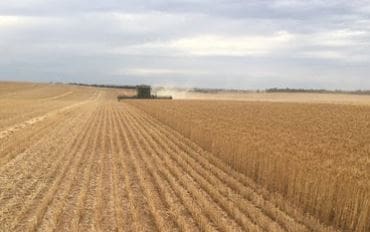LOW rainfall expectations and global price pressures will be among the challenges facing the Australian grain industry in 2019, according to Rabobank’s Agribusiness Outlook 2019 report.
Rabobank expects global wheat prices to come under pressure during the second half of 2019.
Coupled with the new Australian crop supply in the fourth quarter of the year, this will soften local prices, but above-average basis will persist as the local larder is restocked.
For other grains and oilseeds – in an otherwise supportive outlook – the report says a significant bear factor lurks for barley, with an anti-dumping investigation by China into Australian barley exports hanging over the industry’s head, with the potential to disrupt one of the Australian barley industry’s largest trade flows.
Rabobank grains and oilseeds senior analyst, Cheryl Kalisch Gordon, said with global barley stocks at 30-year lows and Australia’s stocks being extremely tight, both local and international support is expected for barley in 2019.
In addition, Rabobank forecasts that China – an importer of Australian feed barley in recent years – will require supplementary feed stocks in coming years as their corn stocks erode faster than industry expectations.
Furthermore, while global beer consumption growth, including in China, has slowed, China remains a significant buyer of malting barley.
The first announcement on China’s anti-dumping investigation into barley, which is allowed 60 days after its initiation, is expected in early February.
The announcement could see the imposition of a temporary tariff duty.
Ms Kalisch Gordon said if that was in the order of the temporary tariff duty placed on United States sorghum last year at 178.6 per cent, it would close the market.
But the case could also be dismissed.
Regardless, the threat of further action will cast a cloud over what is the largest export barley market for Australian producers.
Australian feed and malting barley prices moved to decade-highs in 2018, hand in hand with wheat, and on many occasions with limited to no price spreads.
Domestic feed grain pressures
Local feed grain use has driven demand and is expected to keep prices up, and push prices even higher should we not see a return to average seasonal conditions.
Western Australia and South Australia will supply the east coast deficit, so east coast pricing will remain elevated by either scarce local supply or by incorporating the cost of freight in east coast pricing.
The sorghum crop typically helps meet northern NSW/Queensland feed grain demand in the first half of the year.
However, the ABARES forecast for 1.4 million tonnes (18pc below average), will deliver minimal softening to the feed grain price complex this year.
Rabobank expects continuing high feed-grain prices to prompt expanded cereal hectares at the expense of canola hectares in 2019.
Mounting headwinds
Overall, Rabobank says Australian agriculture is on a strong path, but “headwinds are mounting” and “downside risks” are considerable in 2019.
The report says Australia’s agricultural industries are set to enjoy rising offshore demand and improved market access in the years ahead, while reaping the benefits of growing investment in the sector.
However, it warns, there are “many cyclical and short-term factors” which are less favourable for Australian agriculture entering 2019, including climate and the global economic outlook.
“And some headwinds are rising, while tailwinds are softening,” it says.
Continuing demand growth
The report’s lead author, RaboResearch general manager Tim Hunt, says the next five years will see continuing growth in demand for Australian agricultural produce in global markets, with an additional boost from improving market access.
“Barriers to China will continue to come down under the FTA and the recently-negotiated protocols for a range of products, while the trade benefits we will enjoy under the TPP, especially with Japan, will start to come into play,” he said.
“Added to this, investment which has been attracted into the sector because of these export market opportunities will further boost the sector’s productive and value-adding capacity.”
Price will be the “industry’s friend”
The report says other positive factors playing out in Australian agriculture’s favour are a weak (and falling) currency, combined with strong local price basis, which is ensuring exceptionally-high Australian dollar prices for many key agricultural commodities.
“We expect that a slowing global and local economy, combined with concerns over downside risk, will see Australian exporters enjoy the lowest annual average exchange rate against the greenback in a decade in 2019,” Mr Hunt said.
“Meanwhile, the poor 2018 grain harvest, and low beef and sheep herds, will keep the prices for Australian crops and livestock higher than usual compared with world prices over most or all of 2019.
“And with dairy and sugar markets also tightening globally, and wool markets only likely to see a slow retraction from record levels, price will be the industry’s friend in 2019.”
Climate factors
But Australian agriculture also faces less favourable conditions on many fronts.
Climate factors loom as the “most obvious” problem for the sector in the year ahead, the report says.
“We have opened the year with a majority of eastern Australia in the midst of significant long-term rainfall deficiencies,” Mr Hunt said.
“Murray Darling Basin water storage levels are low and pasture is in poor condition in many grazing regions.
“For winter production to return to average on the east coast this season, above-average rainfall is required in coming months. At present, climate indicators provide mixed signals as to whether that is likely or not.”
At market level, Rabobank says, the global economy is starting to decelerate after two years of strong and rising growth. Locally, Australian consumers also face rising economic pressures as “east coast housing prices enter what looks like a major correction, mortgage rates rise and wages growth remains absent”.
Mr Hunt says forecasts for global economic growth – including by Rabobank – are being reduced, to just below average. “While economic forecasts don’t look too bad, the language economists are using suggests a level of pessimism that is not yet factored into these numbers,” he said.
“What concerns us most in 2019 is not so much the likely path for the global economy – which is less favourable than 2018, but not bad – but the risk something worse may eventuate.”
This includes the slowing Chinese economy and escalating international trade tensions, the report says.
“The slowdown in the Chinese economy is a particular concern for Australian ag,” Mr Hunt said, with China growing at its slowest rate since 1990 in the closing quarter of 2018.
Brexit and the risk of a “calamitous exit” of the United Kingdom from the European Union was also looming large.
“A no-deal departure would have a heavy impact in two key markets for Australian agricultural products,” he said.
The potential of both a worsening or a resolution of the US/China trade war also brought its own set of risks.
“These include flow-on impacts on consumption from a possible US recession if the trade war escalates, or indeed a resolution that favours US agriculture at the expense of Australia,” Mr Hunt said.
Outlook
Overall, the Rabobank report says, if Australia sees a return to “something approaching average rainfall, our base case suggests 2019 will bring a decent year for Australian agriculture – with improved production conditions offsetting what we expect will be somewhat less favourable condition”.
“But Australian agriculture would do well to consider the downside market risks when planning for the next season.”
Source: Rabobank



HAVE YOUR SAY